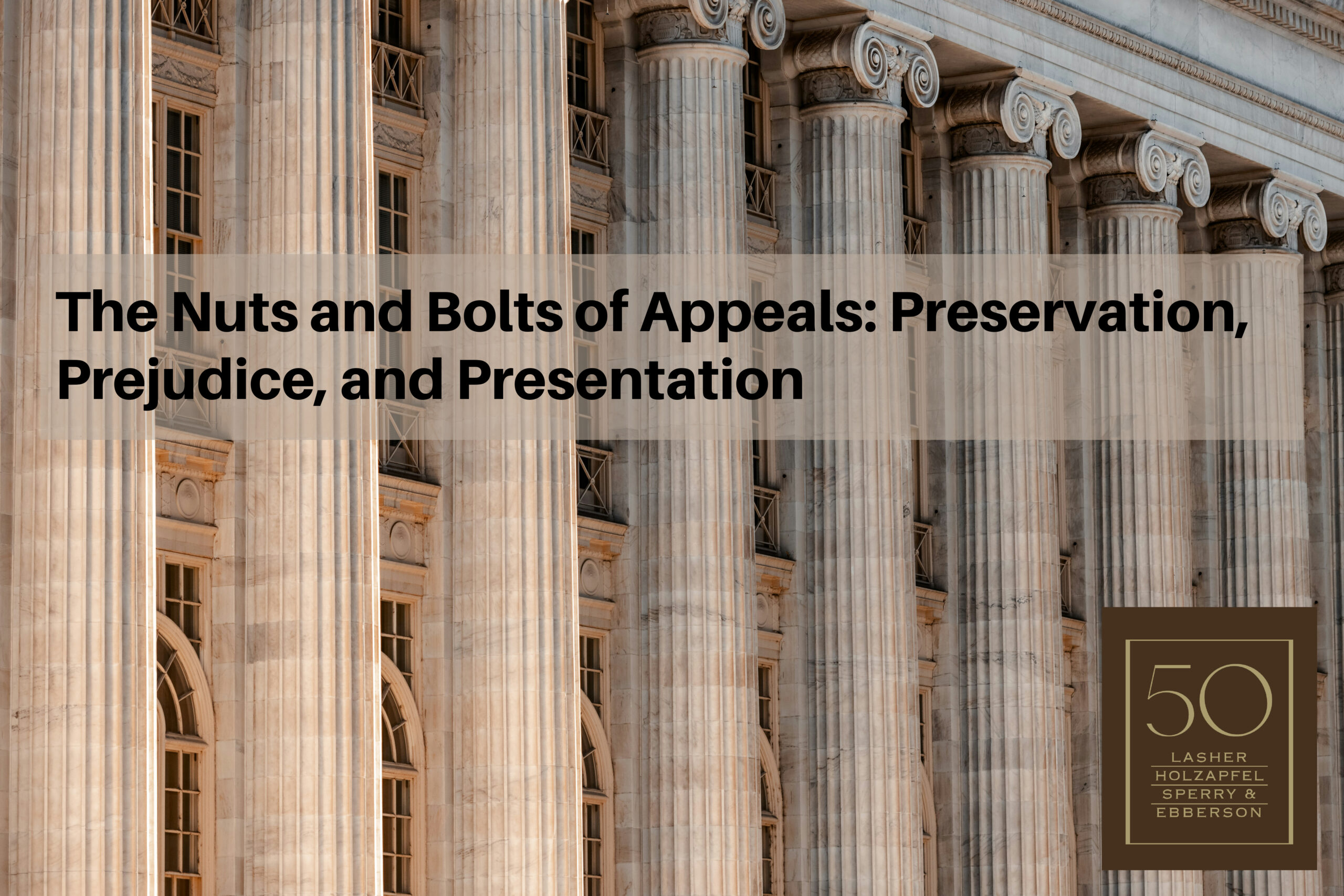The Nuts and Bolts of Appeals: Preservation, Prejudice, and Presentation

Posted on February 16, 2024 by Will Reingold
- Why Appeal at All?
People appeal their case because they want a better outcome then what they received at trial. Maybe that means that the appealing party lost a jury verdict, or felt that they didn’t “win” enough at trial. Perhaps someone in a divorce trial receives 55% of the assets but no spousal support (i.e., alimony), so they appeal the decision not to award support.
If you are considering an appeal, you should be aware of what you are signing up for. In Washington, you have 30 days from the entry of the final court orders to file your notice of appeal.[1] This short timeframe poses its own hurdle: most people who have just finished a trial and received their final orders are often exhausted from grueling and acrimonious litigation. Remember that most cases settle, so the ones that go to trial are in the vast minority. For some, the thought of concluding trial and then immediately pursuing an appeal is daunting.
You should be mindful that the appellate process is markedly different from trial litigation. An appeal is not a do-over, or a second bite at the apple. The appellate court is not a substitute for the trial. Prospective client often says something like, “My attorney did not ask me questions about XYZ like I wanted, so I did not get to testify to an important part of my case.” Unfortunately, that is not a cognizable ground for appeal. There has to be a legal basis to prevail on appeal, which is why an appellate attorney can help you understand the legal issues you are permitted to bring to the Court of Appeals.
- “Preserving” Your Appeal
The concept of preserving your appeal can sometimes be forgotten until it is too late. The Rules of Appellate Procedure provide that “the appellate court may refuse to review any claim of error which was not raised in the trial court.”[2] Ordinarily, a party must “contemporaneously object to preserve an error.”[3] Why? Because the failure to raise an objection or argument contemporaneously means the trial judge did not have the opportunity to rule on the objection or cure the alleged error. Giving the judge this opportunity to correct the alleged error “avoid[s] needless appeals and retrials.”[4] In other words, failing to object deprives the trial judge of the ability to get the decision right in the moment. The appellate court will often elect not to consider these unpreserved issues on appeal.[5]
- Arguments on Appeal
Proving reversible legal error on appeal comes in different shapes and sizes. Perhaps inadmissible hearsay was entered into the evidence. Maybe the trial judge’s ruling mischaracterized some facts presented at trial, and that mischaracterization adversely affected the overall outcome. Or perhaps the trial judge simply did not abide by the case law or state statutes that govern the proceedings—a recent example of this can be seen in Cowan v. Cowan, where the Court of Appeals reversed a parenting plan for failure to follow statutory procedures: “The court did not merely modify ‘residential aspects’ as contemplated by RCW 26.09.260(6). Instead, the court imposed limitations on Joshua’s residential time that was tied to completion of conditions imposed based on the existence of a DVPO that Joshua could not contest at trial.”[6]
The arguments themselves must be grounded in the case law, but they also have to tie into the facts of your case in practical, pragmatic ways. A promising case includes arguments that appeal to the heart and the head. Often that means explaining the commonsense ramifications of one’s arguments. As one judge put it, “[t]he judicial mind is not a tabula rasa. It is informed, enriched, by a judge’s experiences, impressions, temperament, and outside reading, which increasingly is the reading of online materials.”[7]
- Showing “Prejudice”
Most important, for any appeal you must show the court that the error prejudiced your case. In this context, prejudice means that the alleged error had practical and identifiable consequences in the trial of the case.[8] You must show that the outcome would have been changed had the error not been made. By the same token, a small and insignificant error—even if it is a bona fide error—will not prompt the Court of Appeals to reverse the decision. This is easy to grasp in a criminal case: imagine someone’s testimony included hearsay that should not have been admitted; but, at the same time, there were eyewitnesses to the crime, finger prints showing the defendant was at the scene, and a partial confession from the defendant. In that case, given the breadth of evidence, the defendant is almost certainly not going to be able to show that his entire case was prejudiced by the hearsay admission.
The Cowan case mentioned above is another good example of this in a civil setting. The Court of Appeals did find that the trial judge erred, but did not deem there to be prejudice: “Although the trial court abused its discretion in precluding Joshua from introducing evidence challenging the spanking incident, the error was harmless as to the decision to grant Amanda’s request to relocate the children because the spanking incident did not play a factor in that decision. Thus, we affirm the relocation order.”[9] And bear in mind that “[t]he mere possibility of prejudice is not sufficient to meet the burden of showing actual prejudice.”[10] It has to be demonstrated on appeal, so you will have to talk to your appellate counsel about whether such demonstration is feasible.
[1] Rule of Appellate Procedure § 5.2(a).
[2] Rule of Appellate Procedure § 2.5(a).
[3] State v. Paumier, 176 Wn.2d 29, 36 (2012).
[4] LLRIG Two, LLC v. RV Resort Management, LLC, 199 Wn. App. 1067 (Div. II, 2017)
[5] There are exceptions. For instance, the rules allow an unobjected to error to be raised on appeal if it is a “manifest error affecting a constitutional right.” Rule of Appellate Procedure § 2.5(a). It’s best not to tempt fate in these situations and simply make sure the issue is preserved.
[6] Cowan v. Cowan, 534 P.3d 853, 866 (Div. I, 2023).
[7] Richard A. Posner, Judicial Opinions and Advocacy in Federal Courts, 51 Duq. L. Rev. 3, 37-38 (2013).
[8] State v. O’Hara, 167 Wn.2d 91, 99 (2009).
[9] Cowan, 534 P.3d at 868.
[10] State v. Norby, 122 Wn.2d 258, 264 (1993).
